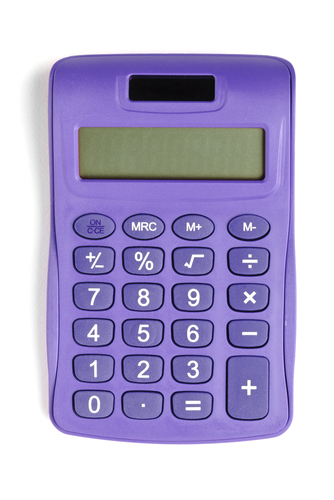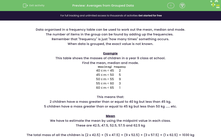What does it make you think of when we say grouped and ungrouped data?

Grouped data is exactly what it sounds like - the data was grouped together into groups!
For example, this table shows the grouped data of masses of students in a class:
| Mass (m kg) | Frequency |
|---|---|
| 40 ≤ m < 45 | 2 |
| 45 ≤ m < 50 | 5 |
| 50 ≤ m < 55 | 9 |
| 55 ≤ m < 60 | 3 |
| 60 ≤ m < 65 | 1 |
The data was collected and organised into groups:
2 children are in the group 40 ≤ m < 45 so have a mass greater than or equal to 40 kg but less than 45 kg.
5 children are in the group 45 ≤ m < 50 so have a mass greater than or equal to 45 kg but less than 50 kg
etc.
Ungrouped data is when we have no groups and we would have e.g. 2 children with the exact weight 42.1 kg, then 3 children with 43 kg etc
Can you see that when we have grouped data, we don't know exactly what the values are?

Let's have a look at how to find our averages of mean, median and mode for grouped data:
Mean
We have to estimate the mean by using the midpoint value in each class.
For example, 42.5 is the midpoint for 40 ≤ m < 45 since 42.5 is right in the middle between 40 and 45.
So the midpoints are 42.5, 47.5, 52.5, 57.5 and 62.5 kg
We multiply these by their respective frequencies to get the total mass of all the children:
(2 x 42.5) + (5 x 47.5) + (9 x 52.5) + (3 x 57.5) + (1 x 62.5) = 1,030 kg
There are 2 + 5 + 9 + 3 + 1 = 20 children in the class.
So, the estimated mean mass = 1,030 ÷ 20 = 51.5 kg

Median
There are 20 children, so the 'middle person' will be the (20 + 1) ÷ 2 = 10.5th person, i.e. the value between the 10th and 11th.
There are 2 people in the 40 ≤ m < 45 class.
Then the next 9 (i.e. the 3rd to 2 + 9=11th) are in the 50 ≤ m < 55 class.
So the 10th and 11th person both fall into the 50 ≤ m < 55 class.
Since we have grouped data and so don't know the exact values, we have the median class: 50 ≤ m < 55 kg
.jpg)
Mode
This is the class with the highest frequency.
We can see that the highest frequency here is 9 which corresponds to 50 ≤ m < 55 kg
So the modal class is 50 ≤ m < 55 kg
Let's grab a calculator and have a go at some questions!

If you get stuck, remember you can always click on the red button at the side of the screen and it will show you this introduction again.







